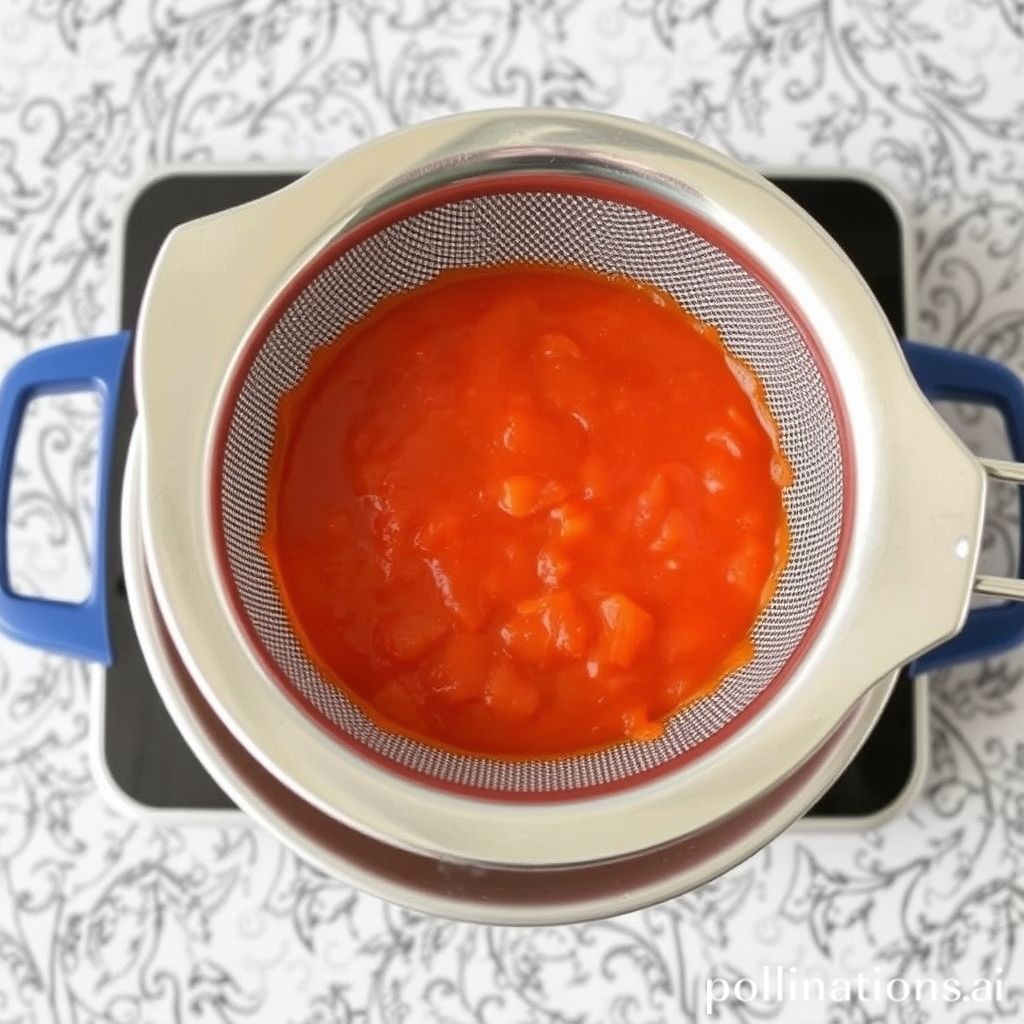How To Make Tomato Juice Out Of Tomato Sauce?
[su_note note_color=”#fb8e00″ text_color=”#000000″ radius=”12″]To make tomato juice from tomato sauce, dilute the sauce with water or broth until desired consistency is reached. Add seasonings like salt, pepper, and herbs for flavor. Simmer and stir, then strain to remove any solids. Homemade tomato juice is versatile for cooking and cocktails, and it’s easy to customize.[/su_note]
We’ll reveal the secret to transforming your tomato sauce into a delicious and nutritious beverage. Whether you’re craving a refreshing drink or a versatile base for your culinary creations, our step-by-step guide will leave you amazed.
Get ready to impress your taste buds and guests alike as we explore the art of making tomato juice from tomato sauce. Say goodbye to bland and hello to a tantalizing burst of flavor. Let’s dive in!

Gathering the Ingredients
List of Ingredients Needed for Making Tomato Juice
To make tomato juice out of tomato sauce, you will need the following ingredients:
1. Tomato Sauce: Start with a high-quality tomato sauce as the base for your juice. Look for a sauce that is made from ripe tomatoes and has a rich flavor.
2. Water: You will need water to dilute the tomato sauce and achieve the desired consistency for your juice. Use filtered water for the best taste.
3. Seasonings: Enhance the flavor of your tomato juice by adding seasonings such as salt, pepper, garlic powder, or herbs like basil or oregano. Adjust the seasonings according to your taste preferences.
4. Optional Ingredients: If you prefer a tangier taste, you can add a splash of lemon juice or a dash of Worcestershire sauce. Additionally, you can add a pinch of sugar to balance the acidity of the tomatoes.
Tips for Selecting the Right Tomato Sauce
Choosing the right tomato sauce is crucial for making delicious tomato juice. Here are some tips to help you select the best sauce:
1. Check the Ingredients: Read the label and make sure the tomato sauce contains only natural ingredients without any artificial additives or preservatives. Look for sauces made from real tomatoes.
2. Flavor Profile: Consider the flavor profile of the tomato sauce. Some sauces may have added herbs or spices, which can influence the taste of your tomato juice. Choose a sauce that complements your desired flavor.
3. Consistency: The consistency of the tomato sauce will affect the thickness of your juice. If you prefer a thicker juice, opt for a sauce with a thicker consistency. For a lighter juice, choose a sauce with a smoother texture.
4. Organic Options: If you prefer organic products, look for tomato sauces that are labeled as organic. These sauces are made from organically grown tomatoes without the use of synthetic pesticides or fertilizers.
Remember, the quality of your ingredients will greatly impact the taste of your homemade tomato juice. By selecting the right tomato sauce and using fresh, flavorful ingredients, you can create a refreshing and nutritious beverage. Enjoy the process of making your own tomato juice and experiment with different flavors to find your perfect blend.
[su_highlight background=”#f6b40f”]Choose a high-quality tomato sauce, add water and seasonings. Consider organic options for a healthier choice. Experiment with flavors for your perfect blend.[/su_highlight]
Preparing the Tomato Sauce
Heating the Tomato Sauce on the Stovetop
To make tomato juice out of tomato sauce, start by heating the sauce on the stovetop. Place a saucepan on medium heat and pour the tomato sauce into it. Stir occasionally to prevent sticking. Heating the sauce breaks down its consistency, making it easier to transform into juice.
Adding Water to Dilute the Sauce
Once the tomato sauce is heated, the next step is to dilute it with water. Gradually pour water into the saucepan while stirring continuously. The amount of water needed depends on the desired thickness of the tomato juice. Add more water for a thinner consistency and less water for a thicker juice. Remember that adding water will reduce the intensity of the tomato flavor, so adjust accordingly.
Seasoning the Sauce with Herbs and Spices
To enhance the flavor of the tomato juice, season the sauce with herbs and spices. Common options include basil, oregano, garlic powder, onion powder, salt, and black pepper. Add these seasonings to the saucepan and stir well to distribute the flavors evenly. The amount of seasoning can vary based on personal preference, so taste the juice as you go and adjust accordingly.
| Step | Description |
|---|---|
| 1 | Heat the tomato sauce on the stovetop |
| 2 | Add water to dilute the sauce |
| 3 | Season the sauce with herbs and spices |
By following these simple steps, you can transform tomato sauce into refreshing tomato juice. Experiment with different herbs and spices to create your desired flavor profile. Enjoy the homemade goodness of tomato juice!
Straining Tomato Sauce to Make Tomato Juice
Method A: Using a Fine-Mesh Strainer or Cheesecloth
To extract tomato juice from tomato sauce, one effective method is to strain the sauce using a fine-mesh strainer or cheesecloth. This process separates the juice from the solids, resulting in a smooth and flavorful tomato juice. Follow these steps:
- Prepare the strainer or cheesecloth: Place a clean fine-mesh strainer or double layer of cheesecloth over a large bowl or pitcher.
- Pour the tomato sauce: Carefully pour the tomato sauce into the strainer or cheesecloth without applying pressure.
- Allow the juice to strain: Let the tomato sauce sit in the strainer or cheesecloth for a few minutes, allowing the juice to strain through while leaving behind the solids.
- Collect the tomato juice: Gently stir the sauce in the strainer or cheesecloth to encourage the juice to flow through. Use a spoon or spatula to press down on the solids and extract as much juice as possible.
- Transfer the juice: Carefully transfer the extracted tomato juice to a separate container or bottle. Refrigerate it for immediate use or freeze it for later.
Method B: Pressing the Sauce to Extract the Juice
Another method to make tomato juice from tomato sauce is by pressing the sauce. This technique requires more effort but yields excellent results. Here’s how to do it:
- Prepare a fine-mesh strainer: Set up a clean fine-mesh strainer over a bowl or pitcher.
- Pour the tomato sauce: Pour the tomato sauce into the strainer, spreading it evenly.
- Apply pressure: Use the back of a spoon or a spatula to press down on the sauce, applying gentle pressure to extract the juice from the solids.
- Continue pressing: Keep pressing and stirring the sauce until you’ve extracted as much juice as possible. Be patient and thorough in this process.
- Collect the tomato juice: Once satisfied with the amount of juice extracted, carefully transfer it to a separate container. Store it in the refrigerator or freezer for later use.
Discarding the Remaining Solids
After straining or pressing the tomato sauce to extract the juice, you’ll be left with solids such as seeds, skin, and pulp. These solids have served their purpose in flavoring the juice but are no longer needed. Simply dispose of them in your compost or trash bin.
By following these methods, you can easily transform tomato sauce into delicious and refreshing tomato juice. Enjoy it as a standalone beverage or use it as a base for soups, cocktails, or other culinary creations.

How to Make Tomato Juice Out of Tomato Sauce?
Adjusting the Flavor and Consistency
To make delicious tomato juice from tomato sauce, it’s important to adjust the flavor and consistency to suit your taste preferences. Here are the steps to achieve the desired results:
Tasting the Tomato Juice and Making Adjustments
1. Start by pouring a small amount of tomato juice into a glass.
2. Take a sip and evaluate the flavor. Is it too tangy, sweet, or bland?
3. If the tomato juice is too tangy, add a pinch of sugar to balance the acidity. Stir well and taste again. Repeat until the desired level of acidity is achieved.
4. Conversely, if the tomato juice lacks tanginess, add a few drops of lemon juice or a pinch of citric acid. Taste after each addition and adjust accordingly.
5. Continue this process of tasting and adjusting until you are satisfied with the flavor.
Adding Salt, Sugar, or Other Seasonings if Desired
1. If the tomato juice lacks saltiness, add a pinch of salt and stir well. Taste and adjust as needed.
2. For those who prefer sweeter tomato juice, add a small amount of sugar. Start with a teaspoon and increase gradually if desired. Remember to taste after each addition.
3. You can also experiment with seasonings like black pepper, garlic powder, or herbs such as basil or oregano. Add these seasonings sparingly, tasting as you go, until you achieve the desired flavor profile.
Adjusting the Consistency by Adding Water or Tomato Sauce
1. If the tomato juice is too thick, gradually add water until you reach the desired consistency. Stir well and assess the texture before adding more water.
2. On the other hand, if the tomato juice is too thin, add a small amount of tomato sauce to thicken it. Mix well and evaluate the consistency before adding more sauce.
To summarize, adjusting the flavor and consistency of tomato juice made from tomato sauce is a simple process. By tasting, making small adjustments, and experimenting with seasonings, you can create a delicious and personalized tomato juice tailored to your preferences. Enjoy the journey of perfecting your homemade tomato juice.
| Information |
|---|
| Adjust the flavor by tasting and adding sugar or lemon juice. |
| Enhance the taste with salt, herbs, or other seasonings. |
| Modify the consistency by adding water or tomato sauce. |
[su_note note_color=”#ea2e0c” text_color=”#ffffff” radius=”8″]Extra Tips: Customize your tomato juice by adjusting flavor with sugar or lemon juice, enhancing taste with salt or seasonings, and modifying consistency with water or tomato sauce.[/su_note]
Storing and Serving Tomato Juice
Proper Storage Methods for Tomato Juice
Properly storing tomato juice is important to keep it fresh and flavorful. Here are some tips to ensure your tomato juice stays delicious:
- Refrigeration: After making tomato juice, transfer it to airtight containers or glass bottles. Store them in the refrigerator at temperatures below 40°F (4°C) to preserve the taste and prevent bacterial growth.
- Freezing: If you have extra tomato juice or want to store it for a long time, freeze it. Pour the juice into freezer-safe containers, leaving space for expansion, and seal them tightly. Frozen tomato juice can last up to six months.
- Canning: Another option is to can tomato juice. Follow the proper canning procedures, including sterilizing jars, using appropriate lids, and processing the jars in a water bath or pressure canner. Canned tomato juice can last up to one year when stored in a cool, dark place.
Serving Suggestions and Creative Uses for Tomato Juice
Tomato juice is not only refreshing on its own but also a versatile ingredient that can enhance various dishes. Here are some serving suggestions and creative uses:
- Classic Tomato Juice: Serve chilled tomato juice in a glass with a sprinkle of salt and a dash of black pepper for a classic and refreshing beverage.
- Base for Cocktails: Tomato juice is the base for popular cocktails like Bloody Mary and Michelada. Experiment with different spices, herbs, and garnishes to create your own signature cocktail.
- Tomato Soup: Use tomato juice as a base for homemade tomato soup. Add sautéed onions, garlic, herbs, and a touch of cream for a comforting and flavorful soup.
- Marinade or Sauce: Tomato juice can be used as a marinade for meats or as a base for sauces. Its tangy flavor adds depth to dishes like braised chicken or barbecue sauce.
Tips for Preserving the Freshness of Homemade Tomato Juice
To keep your homemade tomato juice fresh, consider these tips:
- Use Fresh Tomatoes: Start with ripe, flavorful tomatoes to make the best tomato juice. Fresh tomatoes will result in a more vibrant and delicious juice.
- Strain and Remove Seeds: Strain the tomato juice to remove any seeds or pulp, resulting in a smoother texture. This step also helps extend the juice’s shelf life.
- Add Citric Acid: Adding a small amount of citric acid or lemon juice to the tomato juice can help preserve its freshness and prevent spoilage.
- Properly Seal Containers: Whether storing in the refrigerator, freezer, or canning jars, make sure the containers are tightly sealed to prevent air exposure, which can lead to spoilage.
By following these storage and serving tips, you can enjoy the delicious taste of homemade tomato juice for a long time. Experiment with different recipes and uses to make the most of this versatile ingredient.
Conclusion
Creating your own tomato juice from tomato sauce is a simple and rewarding process. By following the steps outlined in this article, you can enjoy the delicious taste and health benefits of homemade tomato juice. With the ability to adjust the flavor and consistency to your liking, homemade tomato juice offers a personalized experience. Proper storage methods ensure the freshness of your homemade tomato juice for an extended period. So why not give it a try and savor the satisfaction of making your own flavorful tomato juice?
Optimize your blog posts for SEO to increase visibility and reach a wider audience.
[su_divider]
Faq about Making Tomato Juice out of Tomato Sauce
FAQ 1: Can I use canned tomato sauce instead of homemade?
Yes, you can use canned tomato sauce to make tomato juice. Ensure that the canned tomato sauce is of good quality and free from additives or preservatives that may affect the taste or texture of the juice.
FAQ 2: Can I make tomato juice without straining the sauce?
Yes, you can make tomato juice without straining the sauce. However, straining the sauce helps remove seeds and pulp, resulting in a smoother juice. If you prefer a chunkier juice, you can skip the straining step.
FAQ 3: How long can I store homemade tomato juice?
Homemade tomato juice can be stored in the refrigerator for up to 5 days. Store it in an airtight container to maintain freshness and prevent contamination.
FAQ 4: Can I freeze tomato juice for later use?
Yes, you can freeze tomato juice for later use. Pour it into freezer-safe containers, leaving space for expansion. Seal the containers tightly and store them in the freezer for up to 6 months. Thaw the frozen juice in the refrigerator before using.
FAQ 5: What are the health benefits of tomato juice?
Tomato juice is rich in vitamins A, C, and K, as well as antioxidants like lycopene. It promotes heart health, aids digestion, and boosts the immune system. Additionally, tomato juice is low in calories and can help with hydration.

